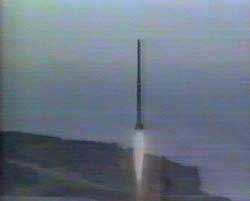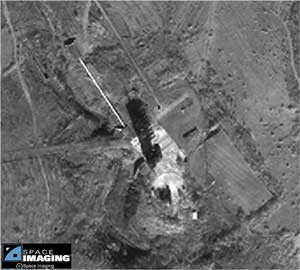 North Korea has begun work on deploying
intermediate range ballistic missiles (with ranges of
3,000 to 4,000km) it developed last year, building
underground bases at two sites. This is much sooner than
South Korean and American military authorities had
expected. North Korea has begun work on deploying
intermediate range ballistic missiles (with ranges of
3,000 to 4,000km) it developed last year, building
underground bases at two sites. This is much sooner than
South Korean and American military authorities had
expected.
A high ranking government source said
Tuesday that, "North Korea is in the middle of
building two underground missile sites in Yangdok
County, South Pyongan Province and Sangnam-ni, Hochon
County, North Hamgyeong Province. Construction is about
70 to 80 percent complete."
The source added, "In particular,
U.S. spy satellites have discovered about 10 of the
newly designed IRBMs and mobile launchers at the two
sites between last year and the beginning of this
year... We presume these bases to be for a new kind of
ballistic missile, not Rodong 1's or Scud's."
Of the ranges of missiles currently
deployed in North Korea, the Rodong 1 has the longest at
1,300 km -- capable of hitting most anywhere in Japan.
The Taepodong 1, developed in 1998 and with a range of
1,600~2,200 km, has yet to be deployed.
 The source said the threat posed by
the new missile, which can reach Okinawa, Gwam and the
vicinity of Hawaii, is part of the background behind the
hastened development by the U.S. of its missile defense
plans. The source said the threat posed by
the new missile, which can reach Okinawa, Gwam and the
vicinity of Hawaii, is part of the background behind the
hastened development by the U.S. of its missile defense
plans.
The new missile, unlike the Taepodong
1 that is launched from a fixed site, is loaded onto a
mobile missile launch vehicle. It is, therefore, highly
mobile.
The missile is presumed to be a
development on the Soviet SS-N-6 sub-launched ballistic
missile; it was originally expected to be revealed
during last year's Sept. 9 Foundation Day parades, but
the 10 missiles and five launchers were simply brought
to Mirim Airbase -- the preparation site for the parades
-- and not featured in the celebrations.
The missiles are 12 meters long and
1.5 wide -- shorter than both the Rodong 1 (15 meters)
and Taepodong 1 (23 meters), but have a much longer
range and are evaluated as a technically advanced type.
Authorities feel that former Soviet
engineers either directly participated in the
development of the missile, the program of which began
in the early 90s and was first confirmed by South Korean
and U.S. intelligence in 2000, or at the very least
Russian technology applied.
Related Story
According to the Korean Times, last
March, part of the warhead of a North Korean missile was
found in Alaska after a test firing of one of North
Korea's new extended range missiles.
The report stated: The warhead of a
long-range missile test-fired by North Korea was found
in the U.S. state of Alaska, a report to the Korean
National Assembly revealed yesterday.
``According to a U.S. document, the
last piece of a missile warhead fired by North Korea was
found in Alaska, former Japanese foreign minister Taro
Nakayama was quoted as saying in the report.
``Washington, as well as Tokyo, has so far underrated
Pyongyang's missile capabilities.ĄŻĄŻ
The report was the culmination of
month long activities of the Assembly's overseas
delegation to five countries over the North Korean
nuclear crisis. The Assembly dispatched groups of
lawmakers to the United States, Japan, China, Russia and
European Union last month to collect information and
opinions on the international issue.
|